March 8th was memorable for many reasons. Not only was it International Women’s Day, but Meghan Markle made one of her first official public appearances with her future husband, Prince Harry, at an event in Birmingham, England. Significantly, the event was organized by the STEMettes, an award-winning social enterprise working across the U.K. and Ireland to inspire young women to pursue STEM careers. The STEMettes were founded in 2013 by a math and science prodigy who had been motivated by the fact that only three of the 70 students in her math and computer science class in college were female. In its first five years, the organization has worked with nearly 40,000 girls, 95 percent of whom have expressed an increased interest in STEM.
Organizations all over the world, such as EngineerGirl in the U.S., are working hard to encourage more women to seek careers in STEM fields, and it is clear that these bodies and their events are having an impact. However, my feeling is that we can and must do more in our schools to increase the number of women represented in STEM careers, not just because of the drive for equality but because we are potentially missing out on a massive pool of talent. It is widely recognized that a career in STEM is more than technical knowledge; increasingly, it requires soft skills such as flexibility, creativity, and judgement. We need to look above and beyond people who rate highly in cognitive ability as it would typically be defined, and create an intentional plan to acquire talent from diverse sources.
One great example is that set by the Haysfield Girls’ School in the U.K. The school has won awards for its efforts in promoting STEM, including specialist days, a science fair, visits to science attractions and from female science role models, and encouraging STEM scholarship programs. The school’s STEM initiatives have been supported by corporations, including Dyson, and The James Dyson Foundation has developed brilliant resources and activities to teach STEM in fun and dynamic ways. Thirty percent of Dyson’s engineers are female, five times the percentage of the overall engineering workforce in the U.K. and almost three times the percentage in the US. When an effort is made to engage girls in STEM, great things will result.
Experiences and ideas formed in early childhood tend to stick. There are organizations doing fantastic work to engage females in STEM, but schools reach kids at an earlier age and need to be more intentional, starting in the early grades about promoting STEM with our female students. Seattle Girls’ School in Washington runs a fantastic annual STEAM camp in August for girls entering 3rd, 4th, and 5th grades. It includes fun workshops and sessions such as garden art, bioengineering fun, Barbie drag races, and SteamPunk design. If girls haven’t had the opportunity to develop interest in STEM by the time they reach adolescence, organizations like STEMettes and EngineerGirl may have a hard time engaging them. But if they already have an affinity, these groups can help them turn interest into achievement.
Another great program that focuses on girls entering the secondary level is The Center for STEM Education for Girls, which was opened by Harpeth Hall School in Nashville in 2011. The Center runs events for students and brings educators and experts together to share research and best practices for teaching and promoting STEM for girls.
STEM is in fact STEAM; we need to plant the arts and humanities at the heart of the story. The future of human potential relies on the marriage of technology and creativity. We need to be better at encouraging the integration of cross-curricular themes and drawing out the links between the arts and the sciences. There are some great ideas for cross-curricular STEAM lessons at LessonPlansPage.
As teachers, we need to remember the power of stories. I recently watched the brilliant movie Hidden Figures with my wife, who is a school principal. Watching the film led to days of discussion about women and science. There are some fantastic stories and books to promote STEM for young girls, including Ada Twist, Scientist (), by Andrea Beaty. Share books with your students and get them to respond through a cross-curricular project. We have to make STEM matter to them and that means through context setting and experiential learning. It’s always great to start with a story!
For developers, vendors, and tech providers, remember that children are complex consumers. Just painting tech pink will not work! Girls love creating things, and many enjoy fashion, arts, crafts, and beauty. Develop products that use those interests as access points, not as alternatives. Linking STEM development to the things children love and understand is always the best access point.
Maybe, in truth, we need to be done with labels. It doesn’t matter whether we call it STEM, STEAM, or something else. What’s more important is to remember that children are deeply inquisitive and curious, and they all want to know more about their world and how it works. All children, regardless of gender, are born scientists; the real question we need to be asking is not how we encourage them to become interested in STEM, but how we keep managing to encourage so many kids out of it! With a positive, inclusive mindset toward the STEM fields, we can encourage all students to tap into their natural interests to enjoy and pursue them.
- The evolving requirements of a K-12 school network - April 24, 2024
- A bungled FAFSA rollout threatens students’ college ambitions - April 24, 2024
- How digital tools and AI can enhance social studies - April 23, 2024

